Abstract Daisuke Goto
C#中abstract的用法详解

C#中abstract的⽤法详解abstract可以⽤来修饰类,⽅法,属性,索引器和时间,这⾥不包括字段. 使⽤abstrac修饰的类,该类只能作为其他类的基类,不能实例化,⽽且abstract修饰的成员在派⽣类中必须全部实现,不允许部分实现,否则编译异常. 如:using System;namespace ConsoleApplication8{class Program{static void Main(string[] args){BClass b = new BClass();b.m1();}}abstract class AClass{public abstract void m1();public abstract void m2();}class BClass : AClass{public override void m1(){throw new NotImplementedException();}//public override void m2()//{// throw new NotImplementedException();//}}}Abstract classes have the following features:抽象类拥有如下特征:1,抽象类不能被实例化, 但可以有实例构造函数, 类是否可以实例化取决于是否拥有实例化的权限 (对于抽象类的权限是abstract, 禁⽌实例化),即使不提供构造函数, 编译器也会提供默认构造函数;2,抽象类可以包含抽象⽅法和访问器;3,抽象类不能使⽤sealed修饰, sealed意为不能被继承;4,所有继承⾃抽象类的⾮抽象类必须实现所有的抽象成员,包括⽅法,属性,索引器,事件;abstract修饰的⽅法有如下特征:1,抽象⽅法即是虚拟⽅法(隐含);2,抽象⽅法只能在抽象类中声明;3,因为抽象⽅法只是声明, 不提供实现, 所以⽅法只以分号结束,没有⽅法体,即没有花括号部分;如public abstract void MyMethod();4,override修饰的覆盖⽅法提供实现,且只能作为⾮抽象类的成员;5,在抽象⽅法的声明上不能使⽤virtual或者是static修饰.即不能是静态的,⼜因为abstract已经是虚拟的,⽆需再⽤virtual强调.抽象属性尽管在⾏为上与抽象⽅法相似,但仍有有如下不同:1,不能在静态属性上应⽤abstract修饰符;2,抽象属性在⾮抽象的派⽣类中覆盖重写,使⽤override修饰符;抽象类与接⼝:1,抽象类必须提供所有接⼝成员的实现;2,继承接⼝的抽象类可以将接⼝的成员映射位抽象⽅法.如:interface I{void M();}abstract class C: I{public abstract void M();}抽象类实例:// abstract_keyword.cs// 抽象类using System;abstract class BaseClass // 抽象类{protected int _x = 100; //抽象类可以定义字段,但不可以是抽象字段,也没有这⼀说法.protected int _y = 150;public BaseClass(int i) //可以定义实例构造函数,仅供派⽣的⾮抽象类调⽤; 这⾥显式提供构造函数,编译器将不再提供默认构造函数. {fielda = i;}public BaseClass(){}private int fielda;public static int fieldsa = 0;public abstract void AbstractMethod(); // 抽象⽅法public abstract int X { get; } //抽象属性public abstract int Y { get; }public abstract string IdxString { get; set; } //抽象属性public abstract char this[int i] { get; } //抽象索引器}class DerivedClass : BaseClass{private string idxstring;private int fieldb;//如果基类中没有定义⽆参构造函数,但存在有参数的构造函数,//那么这⾥派⽣类得构造函数必须调⽤基类的有参数构造函数,否则编译出错public DerivedClass(int p): base(p) //这⾥的:base(p)可省略,因为基类定义了默认的⽆参构造函数{fieldb = p;}public override string IdxString //覆盖重新属性{get{return idxstring;}set{idxstring = value;}}public override char this[int i] //覆盖重写索引器{get { return IdxString[i]; }}public override void AbstractMethod(){_x++;_y++;}public override int X // 覆盖重写属性{get{return _x + 10;}}public override int Y // 覆盖重写属性{get{return _y + 10;}}static void Main(){DerivedClass o = new DerivedClass(1);o.AbstractMethod();Console.WriteLine("x = {0}, y = {1}", o.X, o.Y);}}以上所述是⼩编给⼤家介绍的C#中abstract的⽤法详解,希望对⼤家有所帮助,如果⼤家有任何疑问请给我留⾔,⼩编会及时回复⼤家的。
abstract例子

abstract例子
摘要是指对文章、论文或报告等内容进行简洁、概括性的描述,以
便于读者了解全文的主要内容和结论。
下面是一个摘要的例子:
本文旨在研究大气污染对人类健康的影响,并探讨减少氮氧化物排
放对改善空气质量的重要性。
研究采用了大样本量的数据,通过对污
染物浓度和健康指标的相关性分析,发现大气中高浓度的氮氧化物污
染与呼吸系统疾病、心血管疾病等健康问题之间存在显著关联。
此外,我们还调查了某市的氮氧化物排放情况,并使用模型模拟了减少排放
量的效果。
结果表明,减少氮氧化物排放量可以显著降低空气中的污
染物浓度,从而改善人类的健康状况。
综上所述,本研究强调了减少
氮氧化物排放对于保护人类健康和改善空气质量的重要性,为政府制
定环境保护政策和公众健康管理提供了科学依据。
如何写好SCI论文投稿中的Abstract

如何写好SCI论文投稿中的Abstract Abstract是SCI论文投稿中不可或缺的一部分。
它通常作为论文的摘要,摘要的质量很大程度上决定了论文被接受的可能性。
因此,如何写好Abstract是每位研究者必须掌握的技能之一。
2023年,Abstract的写作依然是一项重要的任务。
面对越来越激烈的学术竞争,研究者需要通过Abstract来吸引读者的关注并明确表达自己的研究意义和成果。
下面将介绍一些具体的写Abstract的技巧和注意事项,帮助研究者撰写高质量的Abstract。
首先,Abstract的内容应该准确、简洁、具体。
为了达到这个目的,研究者应该遵循以下几个基本原则:1. 提炼核心内容Abstract不是论文的简单概述,而是针对论文的研究问题、方法和成果进行提炼和总结。
因此,研究者应该首先确定论文的核心问题和贡献,然后将其简洁明了地表达在Abstract中。
2. 使用适当的语言和术语研究者应该使用准确、专业的术语和语言来描述论文的问题和成果。
同时,也要注意使用简洁、易懂的语言,特别是在解释论文的复杂概念和模型时,以便读者能够快速理解。
3. 强调结果和贡献在Abstract中,研究者应该突出论文的贡献和创新点,让读者能够明确地看到论文的价值和意义,从而增加论文的吸引力和可读性。
除了上述基本原则,还有一些细节需要研究者注意,以确保Abstract的质量和可读性。
下面列举了一些具体的技巧和注意事项:1. 遵循SCI期刊的写作规范Abstract的格式和内容要符合SCI期刊的要求,这包括使用适当的字体、字号、行间距、段间距,以及指定Abstract的篇幅等。
研究者应该仔细阅读SCI期刊的投稿说明,确保自己的Abstract符合要求。
2. 遵循逻辑顺序和结构研究者应该遵循逻辑顺序和结构来组织Abstract的内容。
通常来说,Abstract应该包括论文的研究问题、研究方法、主要结果、贡献和意义等。
学术英语写作Unit-5----Abstract
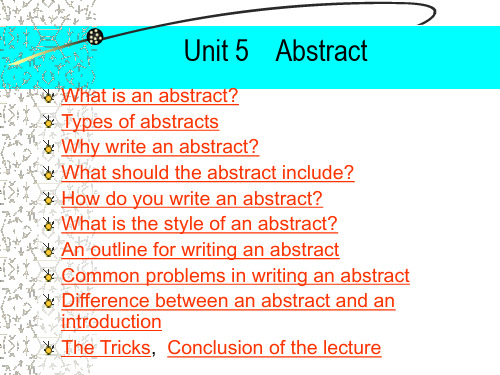
o are short -- from a paragraph to a page or two, depending upon the length of the original work being abstracted. Usually informative abstracts are 10% or less of the length of the original piece.
allow readers to decide whether they want to read the report, article, or paper.
Informative abstracts
An informative abstract provides detail about the substance of a piece of writing because readers will sometimes rely on the abstract alone for information. Informative abstracts typically follow this format:
Unit 5 Abstract
What is an abstract? Types of abstracts Why write an abstract? What should the abstract include? How do you write an abstract? What is the style of an abstract? An outline for writing an abstract Common problems in writing an abstract Difference between an abstract and an introduction The Tricks, Conclusion of the lecture
IntroductiontoAbstractAlgebra.SolutionsManual.…
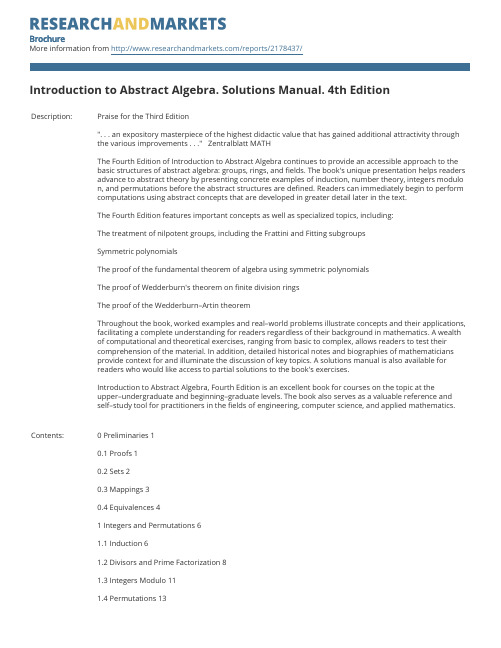
BrochureMore information from /reports/2178437/Introduction to Abstract Algebra. Solutions Manual. 4th EditionDescription:Praise for the Third Edition". . . an expository masterpiece of the highest didactic value that has gained additional attractivity throughthe various improvements . . ." Zentralblatt MATHThe Fourth Edition of Introduction to Abstract Algebra continues to provide an accessible approach to thebasic structures of abstract algebra: groups, rings, and fields. The book's unique presentation helps readersadvance to abstract theory by presenting concrete examples of induction, number theory, integers modulon, and permutations before the abstract structures are defined. Readers can immediately begin to performcomputations using abstract concepts that are developed in greater detail later in the text.The Fourth Edition features important concepts as well as specialized topics, including:The treatment of nilpotent groups, including the Frattini and Fitting subgroupsSymmetric polynomialsThe proof of the fundamental theorem of algebra using symmetric polynomialsThe proof of Wedderburn's theorem on finite division ringsThe proof of the Wedderburn–Artin theoremThroughout the book, worked examples and real–world problems illustrate concepts and their applications,facilitating a complete understanding for readers regardless of their background in mathematics. A wealthof computational and theoretical exercises, ranging from basic to complex, allows readers to test theircomprehension of the material. In addition, detailed historical notes and biographies of mathematiciansprovide context for and illuminate the discussion of key topics. A solutions manual is also available forreaders who would like access to partial solutions to the book's exercises.Introduction to Abstract Algebra, Fourth Edition is an excellent book for courses on the topic at theupper–undergraduate and beginning–graduate levels. The book also serves as a valuable reference andself–study tool for practitioners in the fields of engineering, computer science, and applied mathematics.Contents:0 Preliminaries 10.1 Proofs 10.2 Sets 20.3 Mappings 30.4 Equivalences 41 Integers and Permutations 61.1 Induction 61.2 Divisors and Prime Factorization 81.3 Integers Modulo 111.4 Permutations 132 Groups 172.1 Binary Operations 172.2 Groups 192.3 Subgroups 212.4 Cyclic Groups and the Order of an Element 24 2.5 Homomorphisms and Isomorphisms 282.6 Cosets and Lagrange's Theorem 302.7 Groups of Motions and Symmetries 322.8 Normal Subgroups 342.9 Factor Groups 362.10 The Isomorphism Theorem 382.11 An Application to Binary Linear Codes 433 Rings 473.1 Examples and Basic Properties 473.2 Integral Domains and Fields 523.3 Ideals and Factor Rings 553.4 Homomorphisms 593.5 Ordered Integral Domains 624 Polynomials 644.1 Polynomials 644.2 Factorization of Polynomials over a Field 67 4.3 Factor Rings of Polynomials over a Field 70 4.4 Partial Fractions 764.5 Symmetric Polynomials 765 Factorization in Integral Domains 815.1 Irreducibles and Unique Factorization 815.2 Principal Ideal Domains 846 Fields 886.1 Vector Spaces 886.2 Algebraic Extensions 906.3 Splitting Fields 946.4 Finite Fields 966.5 Geometric Constructions 986.7 An Application to Cyclic and BCH Codes 997 Modules over Principal Ideal Domains 1027.1 Modules 1027.2 Modules over a Principal Ideal Domain 1058 p–Groups and the Sylow Theorems 1088.1 Products and Factors 1088.2 Cauchy s Theorem 1118.3 Group Actions 1148.4 The Sylow Theorems 1168.5 Semidirect Products 1188.6 An Application to Combinatorics 1199 Series of Subgroups 1229.1 The Jordan–H¨older Theorem 1229.2 Solvable Groups 1249.3 Nilpotent Groups 12710 Galois Theory 13010.1 Galois Groups and Separability 13010.2 The Main Theorem of Galois Theory 13410.3 Insolvability of Polynomials 13810.4 Cyclotomic Polynomials and Wedderburn's Theorem 14011 Finiteness Conditions for Rings and Modules 14211.1 Wedderburn's Theorem 14211.2 The Wedderburn–Artin Theorem 143Appendices 147Appendix A: Complex Numbers 147Appendix B: Matrix Arithmetic 148Appendix C: Zorn's Lemma 149Ordering:Order Online - /reports/2178437/ Order by Fax - using the form belowOrder by Post - print the order form below and send to Research and Markets,Guinness Centre,Taylors Lane,Dublin 8,Ireland.Fax Order FormTo place an order via fax simply print this form, fill in the information below and fax the completed form to 646-607-1907 (from USA) or +353-1-481-1716 (from Rest of World). If you have any questions please visit/contact/Order Information Please verify that the product information is correct.Product Format Please select the product format and quantity you require:* Shipping/Handling is only charged once per order.* The price quoted above is only valid for 30 days. Please submit your order within that time frame to avail of this price as all prices are subject to change. Contact InformationPlease enter all the information below in BLOCK CAPITALSProduct Name:Introduction to Abstract Algebra. Solutions Manual. 4th Edition Web Address:/reports/2178437/Office Code:SCBRAUDB QuantityHard Copy(Paper back):USD 93 + USD 27 Shipping/Handling Title:MrMrsDrMissMsProf First Name:Last Name:Email Address: *Job Title:Organisation:Address:City:Postal / Zip Code:Country:Phone Number:Fax Number:* Please refrain from using free email accounts when ordering (e.g. Yahoo, Hotmail, AOL)Payment InformationPlease indicate the payment method you would like to use by selecting the appropriate box.Please fax this form to:(646) 607-1907 or (646) 964-6609 - From USA+353-1-481-1716 or +353-1-653-1571 - From Rest of World Pay by credit card:You will receive an email with a link to a secure webpage to enter yourcredit card details.Pay by check:Please post the check, accompanied by this form, to:Research and Markets,Guinness Center,Taylors Lane,Dublin 8,Ireland.Pay by wire transfer:Please transfer funds to:Account number833 130 83Sort code98-53-30Swift codeULSBIE2D IBAN numberIE78ULSB98533083313083Bank Address Ulster Bank,27-35 Main Street,Blackrock,Co. Dublin,Ireland.If you have a Marketing Code please enter it below:Marketing Code:Please note that by ordering from Research and Markets you are agreeing to our Terms and Conditions at /info/terms.asp。
abstract在c语言中的用法
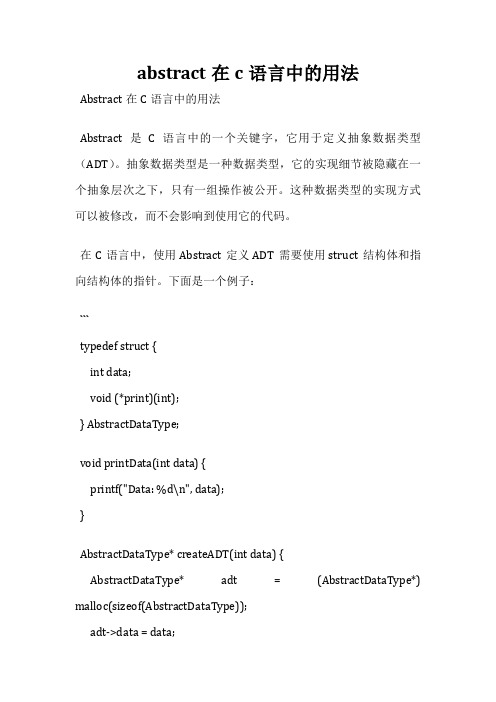
abstract在c语言中的用法Abstract在C语言中的用法Abstract是C语言中的一个关键字,它用于定义抽象数据类型(ADT)。
抽象数据类型是一种数据类型,它的实现细节被隐藏在一个抽象层次之下,只有一组操作被公开。
这种数据类型的实现方式可以被修改,而不会影响到使用它的代码。
在C语言中,使用Abstract定义ADT需要使用struct结构体和指向结构体的指针。
下面是一个例子:```typedef struct {int data;void (*print)(int);} AbstractDataType;void printData(int data) {printf("Data: %d\n", data);}AbstractDataType* createADT(int data) {AbstractDataType* adt = (AbstractDataType*) malloc(sizeof(AbstractDataType));adt->data = data;adt->print = printData;return adt;}int main() {AbstractDataType* adt = createADT(10);adt->print(adt->data);free(adt);return 0;}```在这个例子中,我们定义了一个AbstractDataType结构体,它包含一个整数data和一个指向函数的指针print。
我们还定义了一个printData函数,它用于打印data的值。
createADT函数用于创建一个AbstractDataType对象,并将data和print函数指针初始化。
在main函数中,我们创建了一个AbstractDataType对象,调用了它的print函数,并释放了它的内存。
使用Abstract定义ADT的好处是,它可以将数据类型的实现细节隐藏起来,只公开一组操作。
c++ abstract修饰类用法

C++中abstract修饰类的用法1. 概述在C++中,我们经常会听到关于abstract类的概念。
那么,abstract 类到底是什么?它又有什么作用呢?2. 什么是abstract类在C++中,我们可以使用关键字“abstract”来修饰一个类,使其成为一个“abstract类”。
一个abstract类是一种不能被实例化的类,即不能创建它的对象。
abstract类通常用于定义接口和抽象的行为,它的目的是为了让其他类继承并实现它的纯虚函数。
3. abstract类的定义要定义一个abstract类,我们可以在类中声明纯虚函数。
纯虚函数是指在类中声明但没有实现的虚函数。
通过在函数声明后面加上“= 0”来将一个虚函数声明为纯虚函数。
例如:```C++class AbstractClass {public:virtual void pureVirtualFunction() = 0;};```4. abstract类的作用abstract类的作用主要有以下几点:- 定义接口:abstract类定义了一组接口,表示了一种抽象的行为。
其他类可以继承并实现这些接口。
这样一来,我们就可以通过基类指针来调用派生类的函数。
- 特定行为的约束:abstract类可以约束其派生类必须实现某些特定的行为。
这样一来,我们就可以确保派生类都具有相同的接口,从而提高代码的一致性和可维护性。
- 防止实例化:abstract类的对象不能被创建,这可以防止程序员错误地使用该类,从而避免一些潜在的错误。
5. 如何使用abstract类在C++中,我们可以通过继承abstract类并实现其中定义的纯虚函数来使用abstract类。
例如:```C++class ConcreteClass : public AbstractClass {public:void pureVirtualFunction() override {// 实现纯虚函数的具体逻辑}};```在上面的例子中,ConcreteClass继承了AbstractClass,并实现了其中定义的纯虚函数pureVirtualFunction。
小论文(SCI)Abstract、Introduction和Discussion写作常用句型

Abstract一、在摘要中直接提出论文主题的句型和句式1、In this paper,we present a… approach to…本文提出了一种针对…的…方法。
2、In this paper,we describe improved… models for…本文介绍几种针对…的改进的…模型。
3、We propose a new… model and…algorithm that enables us to…我们提出一种新的…模型和…算法,它让我们能够…4、We present a…model that enables…我们提出了一种…模型,它使我们能够…5、This paper demonstrates the ability of …to perform robust and accurate…本文证明了…进行…可靠准确的…的能力。
6、In this paper we report results of a…approach to…本文报导了…的…方法的实验结果。
7、This paper demonstrates that…can effectively…with very high accuracy.本文证明,…能够有效地准确地…8、The purpose/goal/intention/objective/object/emphasis/aim of this paper is…本文的目的是…9、The primary/chief/overall/main object of this study is to survey…本研究的首要目标是考察…10、The chief aim of this paper/research/study/experiment/the present work is…本文的主要目标是…11 、The emphasis of this study lies in …我们的研究重点是…12、The work presented in this paper focuses on…本文所述工作重点放在…13、Our goal has been to provide…我们的目标是提供…14、The main objective of our investigation has been to obtain some knowledge of …我们的研究目标是获取有关…的知识。
abstractprocessor使用场景
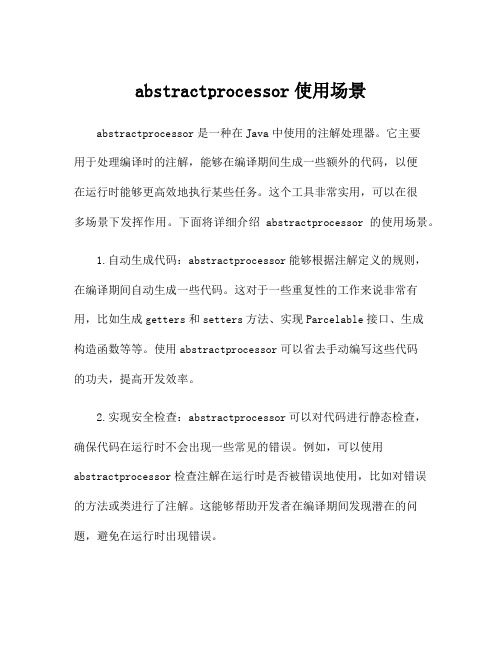
abstractprocessor使用场景abstractprocessor是一种在Java中使用的注解处理器。
它主要用于处理编译时的注解,能够在编译期间生成一些额外的代码,以便在运行时能够更高效地执行某些任务。
这个工具非常实用,可以在很多场景下发挥作用。
下面将详细介绍abstractprocessor的使用场景。
1.自动生成代码:abstractprocessor能够根据注解定义的规则,在编译期间自动生成一些代码。
这对于一些重复性的工作来说非常有用,比如生成getters和setters方法、实现Parcelable接口、生成构造函数等等。
使用abstractprocessor可以省去手动编写这些代码的功夫,提高开发效率。
2.实现安全检查:abstractprocessor可以对代码进行静态检查,确保代码在运行时不会出现一些常见的错误。
例如,可以使用abstractprocessor检查注解在运行时是否被错误地使用,比如对错误的方法或类进行了注解。
这能够帮助开发者在编译期间发现潜在的问题,避免在运行时出现错误。
3.自动生成配置文件:有时候我们需要在编译期间生成一些配置文件,以便在运行时使用。
使用abstractprocessor能够轻松地实现这一功能。
比如,在Android开发中,我们可以使用abstractprocessor生成一些资源文件、Manifest文件等。
这能够提高项目的可维护性,避免手动编辑这些文件可能出现的错误。
4.实现注解驱动框架:注解是一种非常强大的技术,能够在编译期间对代码进行丰富的扩展。
使用abstractprocessor能够方便地实现注解驱动的框架。
通过定义自己的注解,开发者可以使用abstractprocessor来处理这些注解,并生成相应的代码。
这能够大大简化框架的使用,提供更强大的功能。
5.自动生成文档:abstractprocessor可以根据代码中的注解来生成文档,这对于项目的文档自动化是非常有帮助的。
abstract修饰方法总结

abstract修饰⽅法总结
abstract这种⽅法修饰,主要⽤在抽象类和抽象⽅法.
抽象的类是不可实例化的⽐如
public abstract class Test{
}
他能够含有抽象的⽅法
public abstract class Test{
public abstract void defMethod();
}
抽象的⽅法是要让⼦类继承下去再定义它的,让抽象的概念得以设计。
⽐如当⼀种⾯向对象设计遇到⼀种⽅法有多种设计的时候,能够在基类暂且不设计他,把设计的⼯作交给⼦类去完毕,但⼦类设计时,要么继续继承他超类的抽象概念,要么就把抽象的⽅法定义出来。
⽐如
abstract class Test2 extends Test{
……..
}
仍然不定义超类的抽象⽅法,继续把这样的抽象概念交给Test2的⼦类去完毕。
class Test2 extends Test{
public void deMethod(){
}
}
继承Test,让抽象的概念得到设计。
尽管在{}⾥没有不论什么语句,但这也表⽰我们为他做了⼀种设计,⼀种什么也不做的定义。
假设要定义能够写在{}⾥。
总结:
在类中没有⽅法体的⽅法,就是抽象的⽅法。
含有抽象⽅法的类,即为抽象类。
假设⼀个⼦类没有实现抽象基类中全部的抽象⽅法,则⼦类也能够成为⼀个抽象的类。
我们能够将⼀个没有不论什么抽象⽅法的类声明为abstract,避免由这个类产⽣不论什么的对象。
(完整word版)如何写英文Abstract

(完整word版)如何写英文AbstractHow to Write an Abstract一、什么是摘要Abstract?an abstract comprises one paragraph which describes the main content of a paper and appears at the very beginning of the paper.摘要是叙述文章主要内容的一个段落,并且位于文章的开头部分。
摘要是以梗概形式呈现的一篇文章要点的总结,它强调了一篇文章所包含的重要的信息。
它也可以帮助读者快速的了解到是否这篇文章是他们感兴趣的,是否他们需要来阅读整篇文章。
而且,国家或国际出版社的编辑通常通过浏览投稿文章的摘要来决定是否投稿人的文章是可以被录用的。
因此,对于学者和研究人员来说,写一份好的摘要至关重要。
二、写作Abstract的目的对于科技论文的摘要,Abstract的目的有以下几点:1.Introduce journal articles./doc/529728219.html,rm readers about article`s content.3.Help readers decide whether or not to read article.4.Overview conference programs,abstract collections,and book chapters.三、学习写作Abstract的必要性1.Helps you present complex information in a clear,concise manner.2.Helps you read abstracts more effectively.3.Helps you conduct research.4.Helps you write abstracts for future publications.5.Helps you condense report information into a short format for database searches.四、Abstract的写作要求/doc/529728219.html,e one or more well-developed paragraphs,which areunified,coherent,concise,and able to stand alone(200-300 words)./doc/529728219.html,e an introduction-body conclusion structure in which the parts of the parts of the report are discussed inorder:purpose,researcquestions,method,findings,conclusion s,recommendations.3.Follows strictly the chronology of the report.五、Abstract的分类/doc/529728219.html,rmative abstract 内容摘要- the primary research objective or purpose- method employed in solving the problems- principal findings or results- major conclusions and serves as a substitute for the full paper2.descriptive abstract指示性摘要outlines the topics covered in the paper and is like a table of contents in paragraph form.六、Abstract的结构1.Background – why do you want to do the research?2.Research question –what question are you trying to answer and what is the research topic of your paper?3.Method –how (what material, what method, and what procedures) do you get answers to your research question?4.Results – what is your answer to the question?5.Conclusions – what implications does the answer imply?七、Abstract的特点1.Concise –write everything relevant to the paper in as simple terms as possible.2.Objective – states objectively the main points of the paper.3.Consistent – be consistent with the other parts of the whole paper, and never include what has not been mentioned in the paper./doc/529728219.html,plete –cover all the main points of the paper and be a miniature of the paper.5.Brief – conveys in as few words as possible the essential information contained in the body of the paper.八、Abstract的常用句式1、介绍文章背景和目前研究的问题(1) Although (the research subject)…, (the related problem)…is as yet undetermined.(2) (The research subject)…, however, (the related problem)…remains unsolved.(3) (Previous studies) have examined…, (the related problem) is that…, despite…(4) (Problems in certain research area) are…, yet (the present solution) hasfrequently been questioned because…(5) This paper describes/presents…(the argument) within…(a theoreticalcontext)(6) While (the debate on certain research subject) seems to…, (the presentagreement) is still problematic.2、叙述研究目的(1) This pa per advances the view that…(2) The article advocates/discusses/develops/focuses on/gives detailed explanation for/investigates into/proposes/holds that/…(3) The purpose/intention of this paper is…(4) The primary goal/aim of this research is…(5) The ove rall objective of this study is…(6) In this paper/study, we aim at…(7) The work/investigation presented in this paper focuses on…(8) This research is designed to determine/measure/evaluate…(9) The author intends/attempts o outline the framework of/obtain someknowledge of…3、指出观察问题的视角(1) …from the angle of…(2) …in the light of the context that…(3) To view something at a different angle/from various angles…(4) From the point of view of…(5) From the perspective of…4、指出文章参与者(1) The present study has investigated…by using/analyzing…(participants/materials)(2) In this study, we inquired/examined/evaluated…(participants/materials)(3) The experiments/investigations of the present study involved…(participants/materials)5、研究方法和过程(1) Detailed information has been acquired by the authorsusing..(2)Several sets of experiments have been performed to test the validity of…(3) The technique the author adopted is referred to as…(4) The experiments consisted of four steps, which are described in…(5) The met hod/approach used in the present study is…(6) The experiment/investigation in the paper is conducted by adopting…(7)The procedure the present study followed can be briefly described as…(8) The experiment/study consisted of the following steps: …(9) Inc luded in the experiment were…(10) Based on the idea that…, we conducted the present study, categorized…, and evaluated…6、研究结果、发现、结论(1) The results of the experiment indicate/suggest that…; it is also found that…(2) The results are as follows: …(3) The analysis of the samples indicates that..(4) The data obtained seem to be very similar o those reported earlier by…(5) It is concluded that..; the results also imply the further study into…(6) The investigation/experiment varied by…and the results also revealed that…(7) These findings of the research have led the author to the conclusion that…(8) Based on/upon the outcome/findings of the research, …(9) The data/results obtained appear to…, thus we mayconclude that…(10) As a result of the current experiments, we conclude that…(11)The author points out/recommends/concludes that…(12) In summing up it may be stated that…(13) All the preliminary results throw light on the nature of…(14) These findings of the research have naturally led the author to the conclusionthat…九、写一份摘要的步骤(1) 在完成整篇论文之后再来起草你的摘要,因为这样你对文章所表达的观点和发现等才能有一个清楚的轮廓。
抽象类作文英语模版
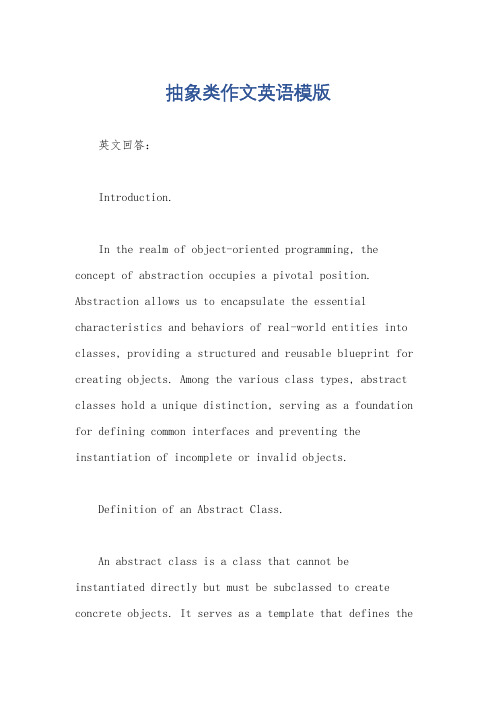
抽象类作文英语模版英文回答:Introduction.In the realm of object-oriented programming, the concept of abstraction occupies a pivotal position. Abstraction allows us to encapsulate the essential characteristics and behaviors of real-world entities into classes, providing a structured and reusable blueprint for creating objects. Among the various class types, abstract classes hold a unique distinction, serving as a foundation for defining common interfaces and preventing the instantiation of incomplete or invalid objects.Definition of an Abstract Class.An abstract class is a class that cannot be instantiated directly but must be subclassed to create concrete objects. It serves as a template that defines theinterface and shared functionality of a group of related classes. By declaring at least one of its methods as abstract, an abstract class ensures that subclasses must implement the method with specific behavior before they can be used.Characteristics of Abstract Classes.1. Cannot be instantiated: Abstract classes cannot be used to create objects directly. They exist solely to provide a blueprint for subclasses to inherit and expand upon.2. Contain abstract methods: Abstract classes declare one or more abstract methods, which are method signatures without implementations. Subclasses must override these abstract methods with concrete implementations to provide specific functionality.3. May contain concrete methods: In addition to abstract methods, abstract classes can also include concrete methods, which provide default implementationsthat subclasses can inherit or override.4. Act as a contract: Abstract classes define a contract that subclasses must adhere to. By implementing the abstract methods, subclasses guarantee that they possess the required functionality and follow the established interface.Uses of Abstract Classes.Abstract classes offer various advantages, including:1. Enforce method signatures: They ensure that subclasses implement the required methods with the correct signatures, preventing inconsistencies and enforcing a common interface.2. Promote code reusability: By providing a shared interface, abstract classes facilitate code reusability across subclasses, reducing duplication and promoting maintainability.3. Prevent incomplete objects: By prohibiting direct instantiation, abstract classes prevent the creation of invalid or incomplete objects, ensuring that only objects with complete and consistent functionality are created.4. Promote polymorphism: Abstract classes support polymorphism, allowing objects of different subclasses to be treated as objects of the abstract class, fostering flexibility and extensibility in code.Example of an Abstract Class.Consider the following abstract class representing the concept of a shape:java.public abstract class Shape {。
如何写abstract和introduction

title
SC-III3, a novel scopoletin derivative, induces autophagy of human hepatoma HepG2 cells through AMPK/mTOR signaling pathway by acting on mitochondria
Abstract基本就是从以上四点非常简明准确,概括的说明了文章的重 心,重点,及所涉及的内容。
Abstract基本写作规则
因abstract位于正文前,中文200-300字,英文为100-500字。因其篇幅 有限,必须十分简练,直截了当。以英文摘要为例,英文摘要的写作原 则为:
1)准确 2)简练 3)清晰 Abstract的要素 目前大部分文章用的是结构式摘要(综述除外),要素包括
论文题目撰写要求
Abstract
以前研 究发现 的现象
为验证目 的所做的
实验
进一步研 究引起现 象所涉及 的细胞内
通路
(E)-3-(4-chlorophenyl)-N-(7-hydroxy-6-methoxy-2-oxo-2H-chromen-3-yl) acrylamide (SC-III3), a newly synthesized derivative of scopoletin, was previously shown to reduce the viability of HepG2 cells and tumor growth of HepG2 xenograft mouse model. It induces the death of HepG2 cells by a way irrelevant to apoptosis and necrosis.. To shed light on the cytotoxic mechanisms of SC-III3, the present study addresses whether and how it can induce autophagic cell death. When HepG2 cells were incubated with various concentrations of SCIII3, autophagic vacuoles could be observed by transmission electron microscopy and monodansylcadaverine staining. Increased expressions of LC3-II to LC3-I and Beclin-1, required for autophagosome formation, were accompanied. These characteristics integrally indicated that SC-III3 could initiate autophagy in HepG2 cells. Nacetyl-L-cysteine (NAC), a ROS scavenger, could reverse SC-III3-caused ROS accumulation, but it did not affect SC-III3induced autophagy, suggesting that ROS was not involved in SC-III3-mediated autophagy in HepG2 cells. SC-III3 significantly depressed mitochondrial function, as evidenced by disruption of mitochondrial transmembrane potential and loss of the mitochondrial cristae structure, as well as decrease of Cox-I, Cox-III, Cox-IV, and ATP levels. The autophagy and activation of AMPK–TSC2–mTOR–p70s6k pathways induced by SC-III3 in HepG2 cells could be efficiently blocked by pre-treatments of compound C (an inhibitor of AMPK).Moreover, addition of extracellular ATP to the cell culture media could reverse SC-III3-caused activation of AMPK–TSC2–mTOR–p70s6k pathway, autophagy and cell viability decrease in HepG2 cells. Collectively, SC-III3 leads to autophagy through inducing mitochondrial dysfunction, depleting ATP, and activating AMPK–mTOR pathway, which thus reflects the cytotoxic effect of SC-III3 in HepG2 cells.
学术英语abstract写作

statements about the latter.
recommendation
thesis
background
Third-hand Smoke
The harm of smoking has long been studied by researchers and many people
Writing an Abstract
2021/10/10
1
What is an abstract?
An abstract is a summary of a scientific
article or a research paper. It covers the
main points of a piece of writing.
the mechanism of
the analysis of
the dependence of
an account of
automation of
2021/10/10
…
is outlined
is described
is addressed
is examined
was carried out
was established
个要素,因而需要缩减摘要的字数和内容。经过压
缩的摘要通常只能突出两个或三个要点,其中最重
要的应该是阐明研究的结果。简要的资料性摘要往
往省略背景知识。如果允许的字数范围内,摘要可
以在最后用一到两句话进行总结并提出建议。一篇
简要的资料性摘要的内容通常包括:
VOID-CONTAINING RESIN MOLDED PRODUCT, PROCESS FOR
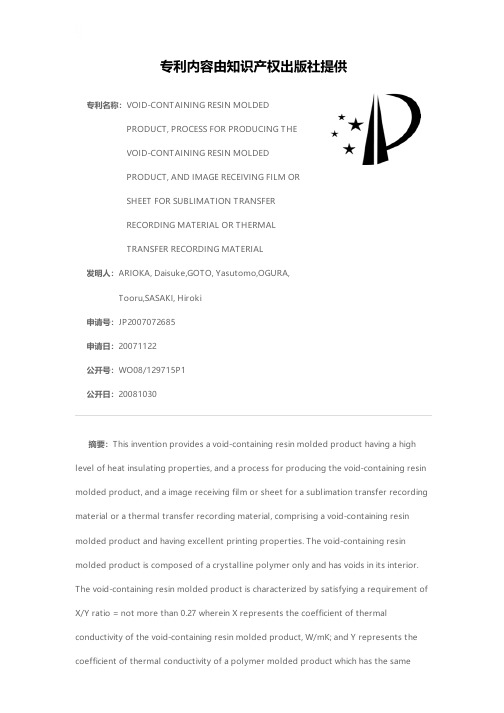
专利名称:VOID-CONTAINING RESIN MOLDEDPRODUCT, PROCESS FOR PRODUCING THEVOID-CONTAINING RESIN MOLDEDPRODUCT, AND IMAGE RECEIVING FILM ORSHEET FOR SUBLIMATION TRANSFERRECORDING MATERIAL OR THERMALTRANSFER RECORDING MATERIAL发明人:ARIOKA, Daisuke,GOTO, Yasutomo,OGURA, Tooru,SASAKI, Hiroki申请号:JP2007072685申请日:20071122公开号:WO08/129715P1公开日:20081030专利内容由知识产权出版社提供摘要:This invention provides a void-containing resin molded product having a high level of heat insulating properties, and a process for producing the void-containing resin molded product, and a image receiving film or sheet for a sublimation transfer recording material or a thermal transfer recording material, comprising a void-containing resin molded product and having excellent printing properties. The void-containing resin molded product is composed of a crystalline polymer only and has voids in its interior. The void-containing resin molded product is characterized by satisfying a requirement of X/Y ratio = not more than 0.27 wherein X represents the coefficient of thermal conductivity of the void-containing resin molded product, W/mK; and Y represents the coefficient of thermal conductivity of a polymer molded product which has the samethickness as the void-containing resin molded product, is formed of the same crystalline polymer as the crystalline polymer constituting the void-containing resin molded product but free from any void, W/mK.申请人:ARIOKA, Daisuke,GOTO, Yasutomo,OGURA, Tooru,SASAKI, Hiroki地址:JP,JP,JP,JP,JP国籍:JP,JP,JP,JP,JP代理机构:HIROTA, Koichi更多信息请下载全文后查看。
如何写abstract和introduction专题知识专家讲座
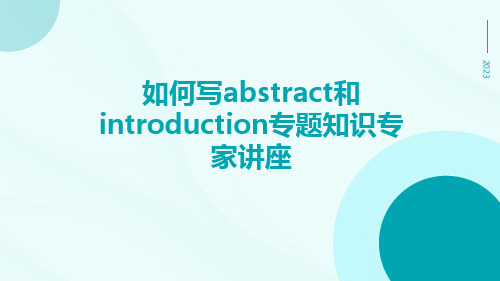
02
好的引言可以使读者对论文产生兴趣,激发其阅读欲望,并帮助其快速了解论 文的研究背景和价值。
03
引言还可以为接下来的正文部分做好铺垫,使读者更容易理解和接受论文的研 究内容和成果。
Introduction的写作技巧
明确研究主题
在引言中要开门见山地说明研究主题,避免绕弯 子,使读者能够迅速了解论文的核心内容。
解决方法
在引言的结尾部分可以对正文内容进行简单的介绍和铺 垫,使读者对接下来要阅读的内容有一个初步的了解。
04
Abstract和Introduction的结合
Abstract和Introduction的联系与区别
Abstract和Introduction都是论文的开篇部分,都起到了吸 引读者和概述文章内容的作用。
分析实例二:Introduction
总结词
引人入胜、建立背景、明确研究问题
详细描述
撰写Introduction时,应首先以引人入胜的方式吸引读者的注意力,建立文章研 究的背景和情境。接着,要明确提出研究问题和目的,阐述该研究对于相关领域 的贡献,并引导读者进入文章的核心内容。
分析实例三
总结词
Abstract和Introduction相互呼应、连贯流畅
2023
如何写abstract和 introduction专题知识专
家讲座
目录
• 引言 • Abstract写作 • Introduction写作 • Abstract和Introduction的结合 • 写作实例分析 • 总结与展望
01
引言
背景介绍
介绍专题的背景和 重要性
提及专题的当前研 究现状和研究意义
Introduction的常见问题及解决方法
TechnicalAbstract
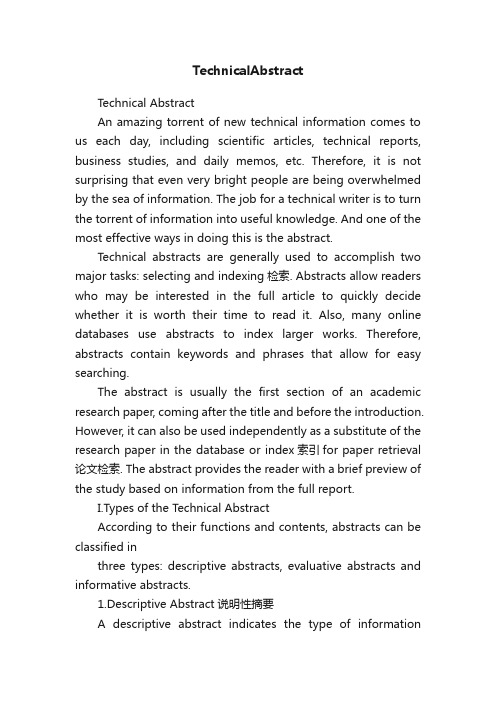
TechnicalAbstractTechnical AbstractAn amazing torrent of new technical information comes to us each day, including scientific articles, technical reports, business studies, and daily memos, etc. Therefore, it is not surprising that even very bright people are being overwhelmed by the sea of information. The job for a technical writer is to turn the torrent of information into useful knowledge. And one of the most effective ways in doing this is the abstract.Technical abstracts are generally used to accomplish two major tasks: selecting and indexing检索. Abstracts allow readers who may be interested in the full article to quickly decide whether it is worth their time to read it. Also, many online databases use abstracts to index larger works. Therefore, abstracts contain keywords and phrases that allow for easy searching.The abstract is usually the first section of an academic research paper, coming after the title and before the introduction. However, it can also be used independently as a substitute of the research paper in the database or index索引for paper retrieval 论文检索. The abstract provides the reader with a brief preview of the study based on information from the full report.I.Types of the Technical AbstractAccording to their functions and contents, abstracts can be classified inthree types: descriptive abstracts, evaluative abstracts and informative abstracts.1.Descriptive Abstract说明性摘要A descriptive abstract indicates the type of informationfound in the work. It merely identifies the areas to be covered in the report. It is an extended statement of purpose or scope, but makes no judgments about the work, nor does it provide results or conclusions of the research. Some people consider it an outline of the work, rather than a summary. Descriptive abstracts are usually very short—100 words or less.Descriptive AbstractThis report analyzes the principles of magnetic refrigeration with application to air conditioning. A comparison with the conventional evaporation-condensation gas cycle device is presented. The applicability of magnetic refrigeration to air conditioning is discussed. 该报告分析了磁制冷用于空调的原理。
- 1、下载文档前请自行甄别文档内容的完整性,平台不提供额外的编辑、内容补充、找答案等附加服务。
- 2、"仅部分预览"的文档,不可在线预览部分如存在完整性等问题,可反馈申请退款(可完整预览的文档不适用该条件!)。
- 3、如文档侵犯您的权益,请联系客服反馈,我们会尽快为您处理(人工客服工作时间:9:00-18:30)。
Computer Generated Clay Animation
Daisuke Goto University of Tsukuba dai@esys.tsukuba.ac.jp
Junichi Hoshino
University of Tsukuba/PRESTO,JST
jhoshino@esys.tsukuba.ac.jp
Abstract
In this sketch, we propose a new technique for computer generated clay animation. Unlike the traditional approaches based on physical simulations, we focus on generating various animation effects produced by the clay animator.
CR Categories: I.3.5 (Computer Graphics): Computational Geometry and Object Modeling – Hierarchy and geometric transformation ; I.3.7 (Computer Graphics): Three-Dimensional Graphics and Realism - Animation
Keywords: clay animation, motion effects, deformation
Retargetting Animation Process
Clay animation is popular in movies and games because of its hand-made flavor. However, making clay animation is very time consuming for modifying models and capturing scenes at every frame. Our approach of generating clay-like animation is to sample the creative process, and retargeting them to the approximate character model. In the current system, we focus on the following two animation effects: 1)Temporal surface deformation by fingers, 2)Generating expressive body motion.
Generating Temporal Surface Deformation
One of the typical animation effects of clay animation is non-uniform surface deformation by pressing clay surfaces by creator’s fingers. To generate temporal surface deformations, we approximate finger’s shape by a mixture of gaussian function. The spacial distribution of the finger location can be determined by sampling real clay animation.
Generating Expressive Body Motion
We classify the typical body motion effects of the clay characters into the following four categories: 1)Anticipation,2)Moving hold,3)Exagerations,4)Follow through. We sample the timing and the degree of the deformation from animation, but apparent motion is different. For example, “moving hold” effects are much longer than the conventional CG animation.
Generating Expressive Body Motion
We classify the typical body motion effects of the clay characters
into the following four categories: 1)Anticipation,2)Moving hold,3)Exagerations,4)Follow through. We sample the timing and the degree of the deformation from animation, but apparent motion is different. For example, “moving hold” effects are much
longer than the conventional CG animation.
Figure3: Simulating temporal surface deformations by fingers
Figure2: Example of generated clay-like appearances
(a) Input keyframe motion
(b) after applying animation effects Figure4: Generating expressive motion
References
S HIMADA , K., MA 1993. Automated Trangulation of Surfaces and Volumes via Bubble Packing. Ph.D.thesis, Massachusetts Institute of Technology, Cambridge, MA.
W.W ELCH , AND A. W ITKIN , 1992. Variational surface nokeling, Computer Graphics and Applications, vol.17, no.5, pp.40-46.
Anticipation
Moving hold & Exaggeration
Follow through 158。
